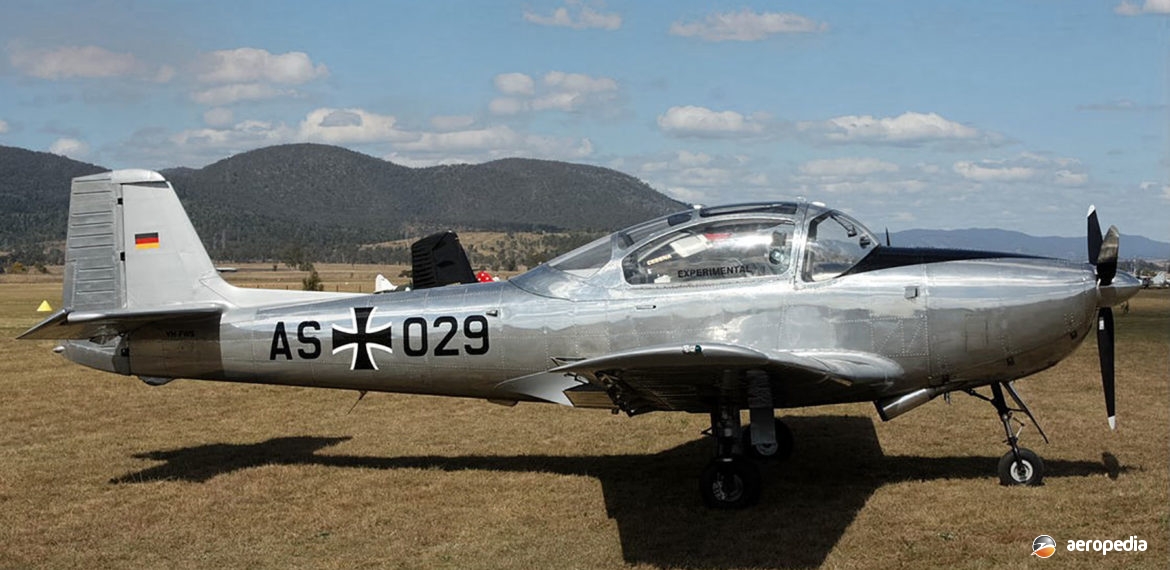Photograph:
Piaggio P-149D VH-FWS (c/n 144) visiting Watts Bridge, QLD (David C Eyre)
Country of origin:
Italy
Description:
Four-seat touring monoplane / military trainer
Power Plant:
One 201 kw (270 hp) Lycoming GO-480 six-cylinder horizontally-opposed air-cooled engine
Specifications:
- Wingspan: 11.12 m (36 ft 5¾ in)
- Length: 8.8 m (28 ft 10½ in)
- Height: 2.85 m (9 ft 4¼ in)
- Wing area: 18.81 m² (202.5 sq ft)
- Max speed at sea level: 312 km/h (194 mph)
- Cruising speed at 70% power at 2,500 m (8,202 ft): 268 km/h (167 mph)
- Initial rate of climb: 300 m/min (984 ft/min)
- Service ceiling: 6,050 m (19,849 ft)
- Range with max fuel: 980 km (609 miles)
- Empty weight: 1,140 kg (2,513 lb)
- Loaded weight: 1,680 kg (3,700 lb)
History:
The Piaggio P-148 was designed by Giovani Casiraghi for Piaggio in Italy as a two-seat training aircraft, the prototype flying for the first time on 12 February 1951. A total of 100 was ordered for the Italian Air Force and was used to equip a number of training schools in the Aeronautica Militaire. Eventually a change in the method of training air force students lead to the aircraft being allotted to regional flying centres.
The type was developed by its designer to the P-149 four-seat touring aircraft with a retractable tricycle undercarriage, the prototype of this new model being flown for the first time on 19 June 1953. It was produced in small numbers and used some structural components from the earlier design. Initial orders were for private owners. In 1955 an example was converted as a demonstrator aimed at the military market, to be used in the liaison and communications roles. Known as the P-149D it was ordered by West Germany and 72 were supplied to the Luftwaffe by Piaggio. A licence to build the type was obtained, 190 being constructed at the Focke Wulf facility at Bremen. Whereas the civil variant had a 194 kw (260 hp) Lycoming GO-435-C2 engine, the military variant had the 201 kw (270 hp) GO-480 unit.
Construction was all metal, and it was fitted with a retractable undercarriage. The cockpit was covered by a large curved canopy which could be jettisoned in an emergency. Dual controls were fitted to the front seats and the type saw many years in service with the Luftwaffe as its basic trainer. Export orders were also received for the military variant for Nigeria, Tanzania and Uganda, some German aircraft later going to other air forces. Eventually a number came on to the civil market and a number are registered around the world.
One example was imported to Coolangatta, QLD in September 2006. This aircraft became VH-FWS (c/n 144 – ex N3279Q, N482FW, N40233, D-ENJF, 91+67, BF+227, AS+029, KB+156) in September 2006 and is painted in post-World War II Luftwaffe markings. This aircraft is recorded as having been the private aircraft of Luftwaffe Ace, General Adolph Galland, after its retirement from German service. The aircraft was built by Focke Wulf and is fitted with a GO-480-B1A6 engine manufacturered by BMW Triebwerkbau GmbH. It was re-registered to Australian Athletic Business Pty Ltd on 3 March 2014.

